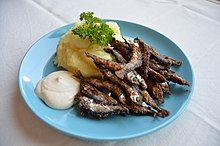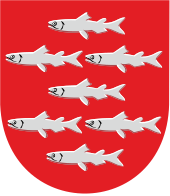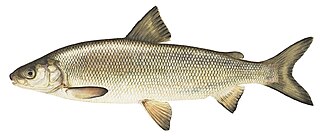
Coregonus is a diverse genus of fish in the salmon family (Salmonidae). The Coregonus species are known as whitefishes. The genus contains at least 68 described extant taxa, but the true number of species is a matter of debate. The type species of the genus is Coregonus lavaretus.

Coregonus lavaretus is a species of freshwater whitefish, in the family Salmonidae. It is the type species of its genus Coregonus.

The ciscoes are salmonid fish that differ from other members of the genus in having upper and lower jaws of approximately equal length and high gill raker counts. These species have been the focus of much study recently, as researchers have sought to determine the relationships among species that appear to have evolved very recently. The term cisco is also specifically used of the North American species Coregonus artedi, also known as lake herring.
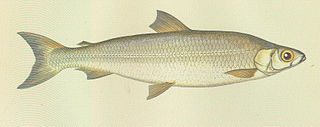
The pollan or Irish pollan is a freshwater whitefish known only from five Irish lakes, Lough Neagh, Lower Lough Erne, Lough Ree, Lough Derg and Lough Allen. The pollan faces competition from introduced species such as pike, roach and zebra mussel, and the populations rely on restocking for survival.

Arctic cisco, also known as omul Russian: Омуль, is an anadromous species of freshwater whitefish that inhabits the Arctic parts of Siberia, Alaska and Canada. It has a close freshwater relative in several lakes of Ireland, known as the pollan, alternatively regarded as conspecific with it, or as a distinct species.

The broad whitefish is a freshwater whitefish species. Dark silvery in colour, and like a herring in its shape. Its distinctive features includes: a convex head, short gill rakers, and a mild overbite. It is found in the Arctic-draining streams, lakes, and rivers of far eastern Russia and North America. Its prey includes larval insects, snails, and shellfish. It is eaten by humans and brown bears.

Coregonus sardinella, known as the least cisco or the sardine cisco, is a fresh- and brackishwater salmonid fish that inhabits rivers, estuaries and coastal waters of the marginal seas of the Arctic Basin, as well as some large lakes of those areas.
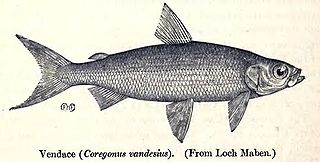
Coregonus vandesius, the vendace, is a freshwater whitefish found in the United Kingdom. Population surveys since the 1960s have revealed a steady decline and the fish is no longer present in some of its previous haunts but is still present in Bassenthwaite Lake and Derwent Water. The main threats it faces are eutrophication and the introduction of alien species of fish which eat its eggs and fry. The International Union for Conservation of Nature has rated its conservation status as "endangered".

The shortjaw cisco is a North-American freshwater whitefish in the salmon family. Adult fish range to about 30 cm (12 in) in length and are silver, tinged with green above and paler below. One of the members of the broader Coregonus artedi complex of ciscoes, it is distributed widely in the deeper lakes of Canada, but populations in the Great Lakes have been declining and it is no longer present in Lakes Michigan, Huron, and Erie. It feeds mainly on crustaceans and insect larvae and spawns in the autumn on the lake bed. It is part of the important cisco (chub) fishery in the Great Lakes. The International Union for Conservation of Nature has rated its conservation status as "vulnerable". Shortjaw cisco have however evolved from the cisco Coregonus artedi independently in different lakes and different parts of the range, and conservation assessments therefore should be made on a lake-wise rather than range-wide basis.
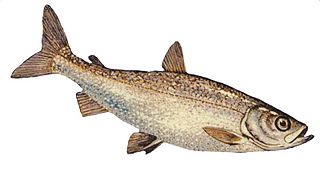
The freshwater whitefish are fishes of the subfamily Coregoninae, which contains whitefishes and ciscoes, and is one of three subfamilies in the salmon family Salmonidae. Apart from the subfamily Coregoninae, the family Salmonidae includes the salmon, trout, and char species of the subfamily Salmoninae, and grayling species of the subfamily Thymallinae. Freshwater whitefish are distributed mainly in relatively cool waters throughout the northern parts of the Northern Hemisphere.

The houting is a European species of whitefish in the family Salmonidae that was long thought extinct. It was native to the estuaries and rivers draining to the North Sea. The houting is distinguishable from other Coregonus taxa by having a long, pointed snout, an inferior mouth and a different number of gill rakers. The houting once occurred in Belgium, France, Germany, the Netherlands and England. In 2023, DNA analysis found the houting to be genetically indistinguishable from Coregonus lavaretus, and therefore not extinct.

The peled, also called the northern whitefish, is a species of freshwater whitefish in the family Salmonidae. It is found in northern Europe and Asia.

The humpback whitefish, also referred to as the bottom whitefish, the Arctic whitefish or the pidschian, is a species of freshwater whitefish with a northern distribution. It is one of the members in the broader common whitefish complex, or the Coregonus clupeaformis complex. This fish lives in estuaries and brackish water near river mouths, in deltas and in slowly running rivers, in large lakes with tributaries, and floodplain lakes. It can migrate long distances upriver for spawning.
Coregonus trybomi is a freshwater whitefish in the family Salmonidae. It is a spring-spawning type of cisco, which probably has evolved from sympatric vendace independently in a number of Swedish lakes. Only one of those populations survives, and it is therefore considered Critically Endangered by the IUCN Red List. The status of Coregonus trybomi as a distinct species is however questionable. By Swedish authorities it is treated as a morphotype or ecotype, not an independent species. It was listed as "Data Deficient" in 2010 but excluded from the national red list in 2015.
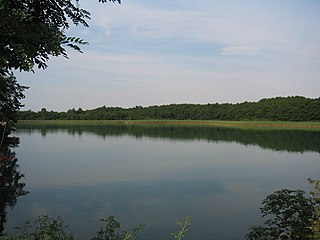
Breiter Luzin is a lake in Mecklenburg-Vorpommern, Germany. At an elevation of 84.3 m, its surface area is 3.45 km². It is home to an endemic dwarfed whitefish, Coregonus lucinensis.
Coregonus fontanae, also known as the Stechlin cisco, Fontane cisco, or Fontane's cisco, is a putative species of freshwater whitefish in the family Salmonidae endemic to the Großer Stechlinsee in northern Germany. It is believed to have recently evolved from the sympatric vendace, Coregonus albula.
Coregonus bavaricus, the Ammersee kilch, is a species of freshwater whitefish endemic to Lake Ammersee in the German state of Upper Bavaria. A small, silver-colored fish, it typically lives between 60–85 m (197–279 ft) deep, though shallower in the summer months. In the early 20th century the Ammersee kilch was an important commercial species, but its population declined drastically in the 1930s onward due to overfishing and eutrophication of the only lake in which it is found. Today it is listed as Critically Endangered by the International Union for Conservation of Nature (IUCN) and may be on the verge of extinction.

Coregonus maraena, referred to in English as the maraene, maraena whitefish, vendace, cisco, lake herring, lake whitefish or the whitefish, is a whitefish of the family Salmonidae that occurs in the Baltic Sea basin - in the sea itself and the inflowing rivers, and in several lakes as landlocked populations. It is found in Denmark, Estonia, Finland, Germany, Latvia, Lithuania, Netherlands, Norway, Poland, Slovakia, Russia and Sweden. As of 2013, it has been listed as a vulnerable species by the IUCN and as endangered by HELCOM. It is an extremely important fish within the Baltic Sea ecosystem, both for population equilibrium and for the local diets of the surrounding human population. Due to a variety of factors, mostly overfishing, the maraena's population dwindled to near-extinction levels. Thus, rampant repopulation was enacted to preserve this important fish.

The lake whitefish is a species of freshwater whitefish from North America. Lake whitefish are found throughout much of Canada and parts of the northern United States, including all of the Great Lakes. The lake whitefish is sometimes referred to as a "humpback" fish due to the small size of the head in relation to the length of the body. It is a valuable commercial fish, and also occasionally taken by sport fishermen. Smoked, refrigerated, vacuum-packed lake whitefish fillets are available in North American grocery stores. Other vernacular names used for this fish include Otsego bass, Sault whitefish, gizzard fish, common whitefish, eastern whitefish, Great Lakes whitefish, humpback whitefish, inland whitefish and whitefish.
Coregonus widegreni, also called the Valaam whitefish, is a putative species of freshwater whitefish, a part of the common whitefish complex from Northern Europe. It is a demersal form of freshwater whitefish that feeds on benthic invertebrates. It spawns in late autumn, and can reach a length of 55 cm maximum. It is characterized by a low gill raker density.

